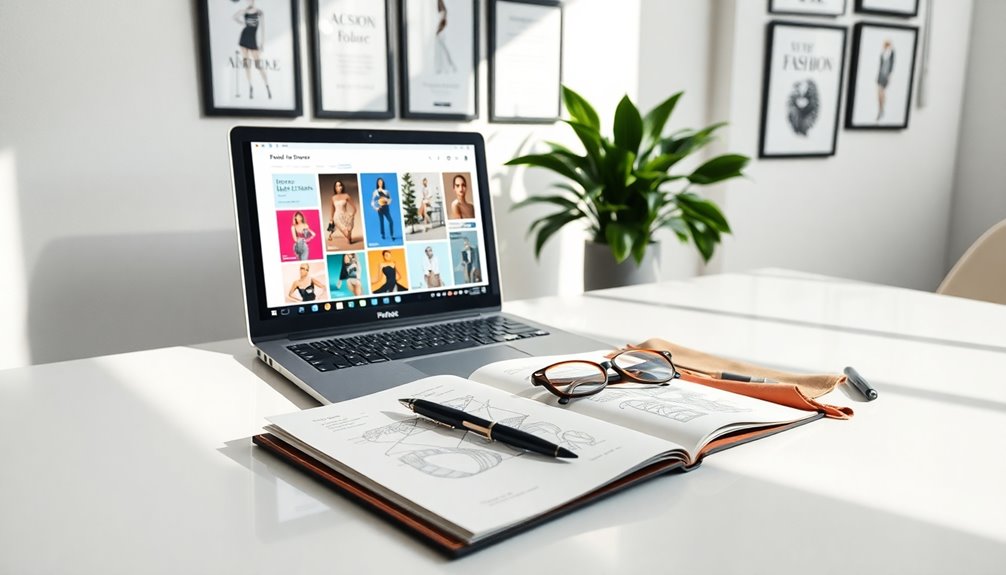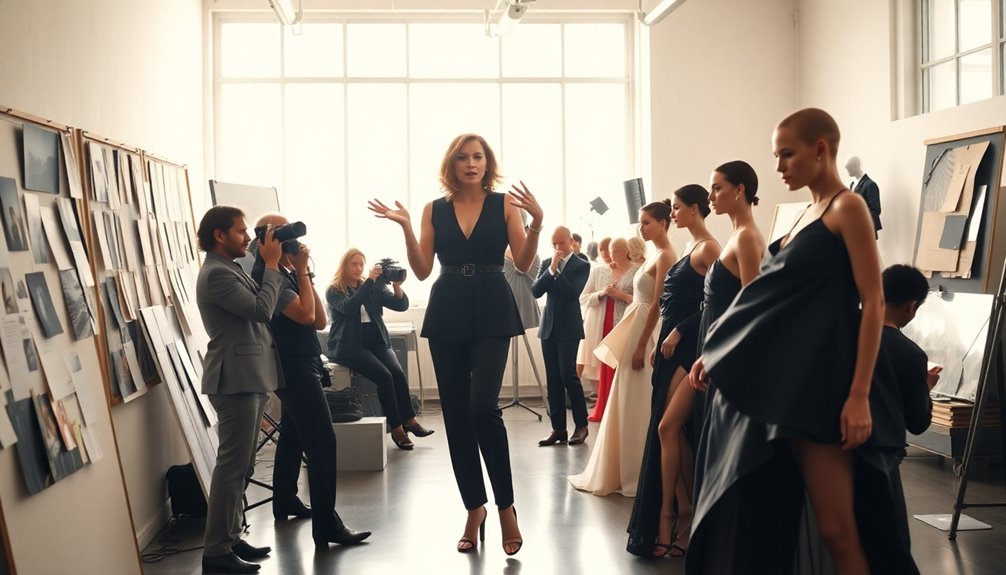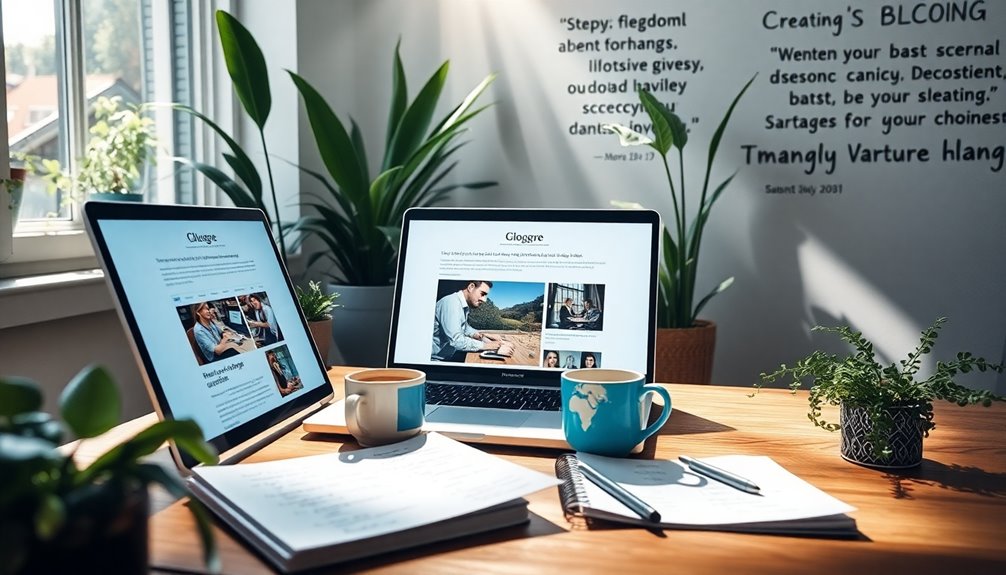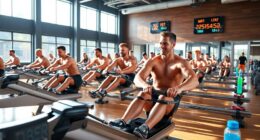To build a standout fashion CV, start with a clean, professional layout that prioritizes readability. Keep it concise—one page is ideal for entry-level positions. Tailor your professional summary to specific roles and highlight relevant work experiences, using action verbs to quantify achievements. Clearly list your education and emphasize skills like CAD proficiency and trend forecasting. Don't forget to showcase notable projects with high-quality visuals that reflect your design process. Lastly, proofread thoroughly to ensure accuracy and professionalism. There's more you can do to enhance your CV for the fashion industry, so keep exploring!
Key Takeaways
- Use a clean, professional layout for your CV, ensuring readability and effective use of white space for a polished appearance.
- Tailor your professional summary and work experience to highlight relevant projects, skills, and achievements specific to the fashion industry.
- Showcase your education prominently, including degrees, relevant courses, and hands-on projects that demonstrate your expertise and practical experience.
- Highlight technical skills, such as proficiency in CAD software and Adobe Creative Suite, alongside creative abilities like sketching and pattern development.
- Include a diverse range of relevant projects in your portfolio, detailing the design process and providing high-quality visuals to capture your work's essence.
Choosing the Right Format

When crafting your fashion CV, choosing the right format is crucial for making a strong first impression. Start with a clean, professional layout that's easy to read. Select a template that features clear headings and bullet points, allowing for quick navigation. Keep your CV to one page, particularly if you're applying for entry-level positions or internships.
Utilize white space effectively to avoid clutter and ensure your information stands out. For experienced candidates, a chronological format is your best bet. This highlights your previous responsibilities and achievements clearly. Remember that recruiters spend approximately 3 seconds on initial resume review, so clarity is key.
If you're newer to the field, consider a functional or combination resume format that showcases your skills and education first. Tailor your format to emphasize your strongest qualifications.
Visual aesthetics matter too; a bold style or subtle background can enhance your design, as long as it remains professional and easy to read. Stick to legible fonts like Arial, Times New Roman, or Helvetica, sized between 10 and 12 points.
Finally, save your CV as a PDF to maintain consistent formatting across devices, which many recruiters prefer for its professional presentation.
Crafting a Professional Summary
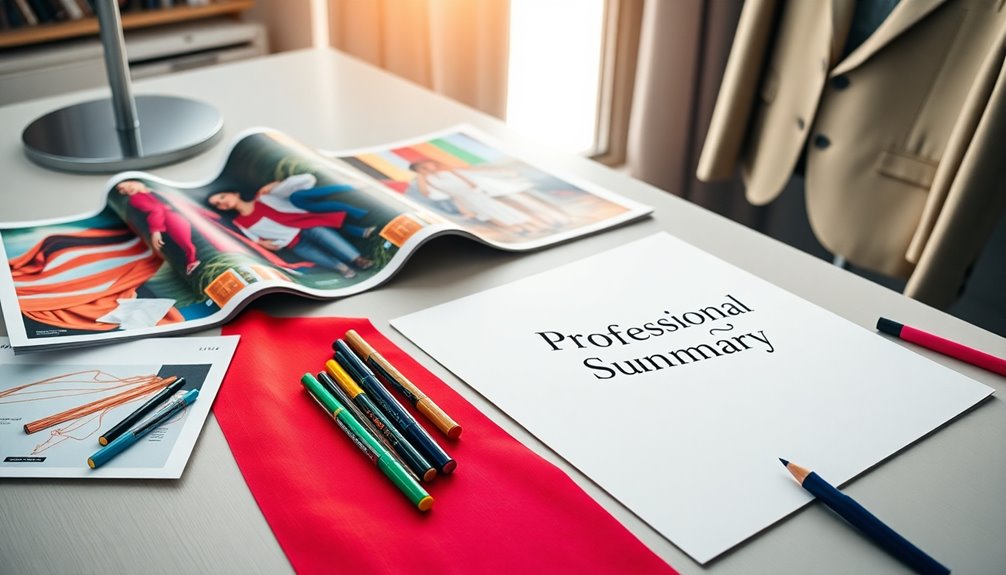
A compelling professional summary can be your ticket to capturing attention in the fashion industry. Start by tailoring your summary to the specific role you're applying for, highlighting your expertise as a fashion consultant or designer. Mention any notable projects or clients you've worked with, focusing on key points that set you apart. Keep it brief and impactful.
Emphasize your career success and experience by detailing relevant skills and achievements in the fashion sector. Include previous roles and any education or certifications that bolster your qualifications. Whenever possible, quantify your achievements to demonstrate your impact. Additionally, highlighting your fashion expertise can significantly enhance your appeal to potential employers.
Identify your niche and specialization clearly. Let hiring managers know the specific style of fashion you create, whether it's sportswear, swimwear, or something else. Align your specialization with the needs of the prospective employer to showcase your fit for the role.
Finally, use a clear and concise writing style. Two or three well-crafted sentences should capture the essence of your qualifications without unnecessary jargon. Begin each point with strong action verbs, ensuring your statement is short and easily understandable while incorporating key qualifications that match the organization's needs.
Writing Work Experience
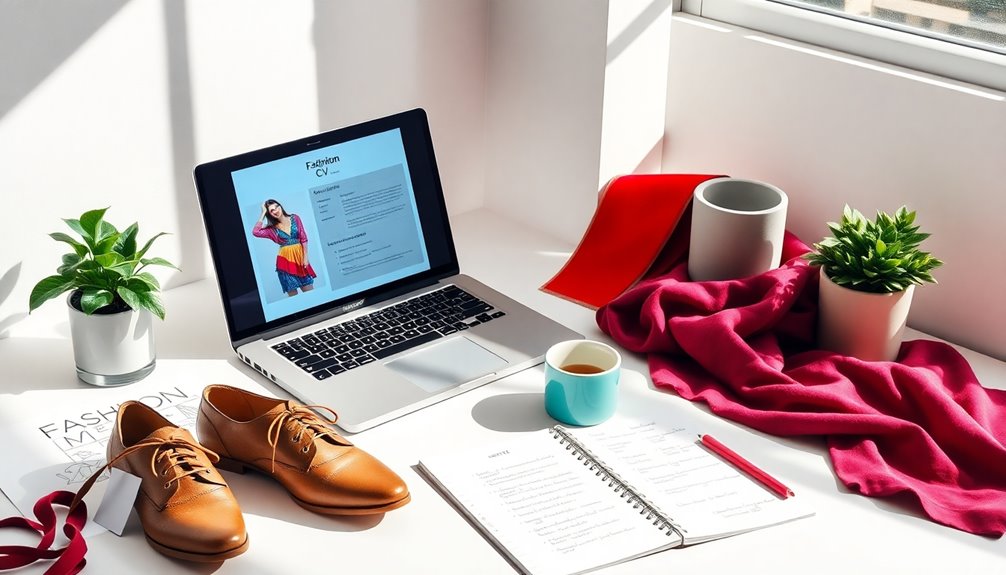
Crafting a strong work experience section is crucial for showcasing your qualifications in the fashion industry. Focus on relevant experiences that align with the job you’re applying for. Use bullet points to clearly describe your roles, projects, and the skills you gained. Start with your most recent experience and include the company name, location, and dates of employment. Be sure to include any internships, part-time jobs, or freelance work that demonstrate your passion for the industry. Highlight any specific achievements or projects that have contributed to your professional development. As you craft this section, keep in mind these fashion career tips to help you stand out to potential employers.
Begin each bullet point with powerful action verbs like "designed," "managed," or "executed." Quantify your achievements to demonstrate your impact—think along the lines of "increased brand sales by 20%." Highlight your main responsibilities and the results of your work rather than just listing tasks. Additionally, a strong resume showcases industry experiences that help you stand out among competition.
If you collaborated on notable projects, mention those to showcase your teamwork skills. Don't forget to customize your entries to match the job description, incorporating relevant keywords. Adding links to your online portfolio or lookbook can provide visual evidence of your work.
Finally, steer clear of generic phrases; opt for dynamic language that reflects your unique contributions to the fashion industry. This focused approach will help you stand out to potential employers.
Highlighting Education
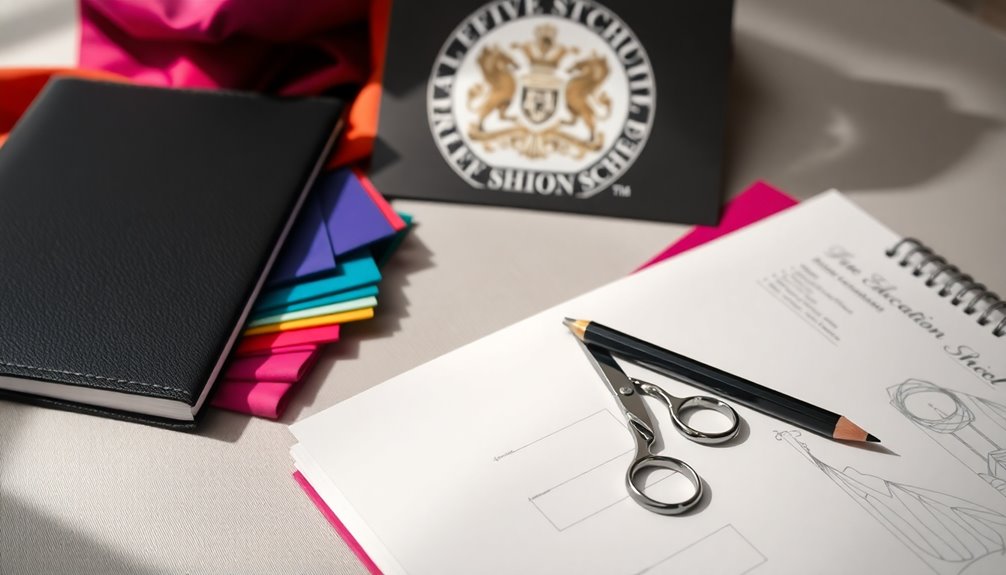
Your education section is just as important as your work experience in a fashion CV. It provides potential employers with insight into your foundational knowledge and skills. Start by listing your degree, typically a Bachelor of Fine Arts (BFA) in fashion or a related field. Don't forget to mention the institution where you obtained your degree and your graduation date.
Include any specializations, such as knitwear or visual merchandising, to highlight your niche expertise. A well-rounded education also involves relevant courses—list subjects like fashion drawing, sewing techniques, and art and fashion history. Additionally, having a strong understanding of industry trends can set you apart in the competitive fashion landscape.
If you completed practical projects, like fashion draping or textile studies, mention these, as they showcase your hands-on experience. If you've taken online courses or earned certifications, create a separate section for these. Include the course title, institution, and date of certification.
Bullet points can effectively convey what you learned and how it applies to the position you're pursuing. Finally, organize your qualifications in reverse-chronological order, emphasizing the most recent and relevant experiences to enhance your CV's impact.
Emphasizing Relevant Skills

When building a fashion CV, highlighting relevant skills is crucial for standing out in a competitive industry. Start by showcasing your technical skills. Proficiency in CAD software and Adobe Creative Suite, along with sewing techniques, can set you apart. Mention your ability to create comprehensive tech packs and your understanding of textile selection. Additionally, having a strong grasp of production techniques demonstrates your capability to transform design ideas into tangible products.
Next, focus on your creative and design skills. Emphasize your creativity in developing new patterns and styles, and your sketching abilities to visualize your ideas. Highlight your grasp of color theory, as it's essential for creating harmonious palettes.
Don't forget to underline your market and trend awareness. Illustrate your knowledge of changing fashion trends, trend forecasting, and how you stay updated through research and trade shows. This shows potential employers you're proactive in understanding the industry.
Finally, include your soft skills. Strong communication and interpersonal skills are vital for interacting with clients and colleagues. Mention your adaptability, attention to detail, and any experience in human resource management.
Tailoring Your CV
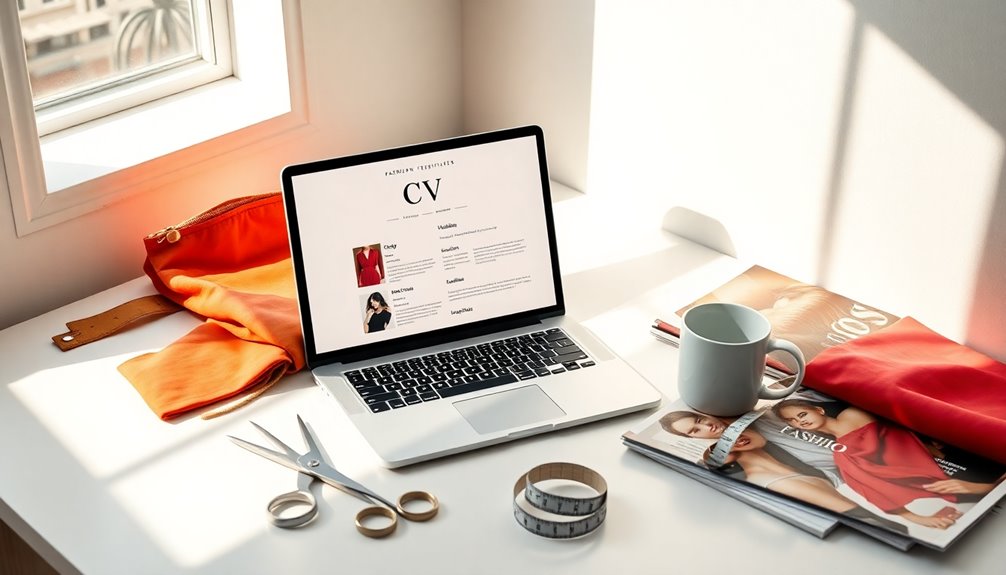
Tailoring a CV specifically for each job application can significantly enhance your chances of landing an interview in the fashion industry. Start by analyzing the job posting; identify key terms and phrases that highlight what the employer seeks. Revise your CV to include these terms, ensuring it aligns with the job requirements.
Customize your CV for each application rather than relying on a one-size-fits-all version. This might mean modifying previous job titles to better reflect the role you're applying for while maintaining honesty. Adjust the layout and content to emphasize the skills and experiences the employer values most.
Highlight relevant experience by using a reverse chronological format, especially if you have significant work history. If your experience is limited, a hybrid format that balances skills and experience can work well.
Describe your accomplishments using bullet points and power verbs like "designed," "built," and "collaborated" to create impact. Additionally, cross-reference skills with job postings to ensure alignment with employer needs.
Finally, maintain a clear and professional format. Use legible fonts, concise headings, and enough spacing to enhance readability. Aim for a CV that's ideally one page long, ensuring it doesn't exceed two pages in length.
Showcasing Projects and Portfolios
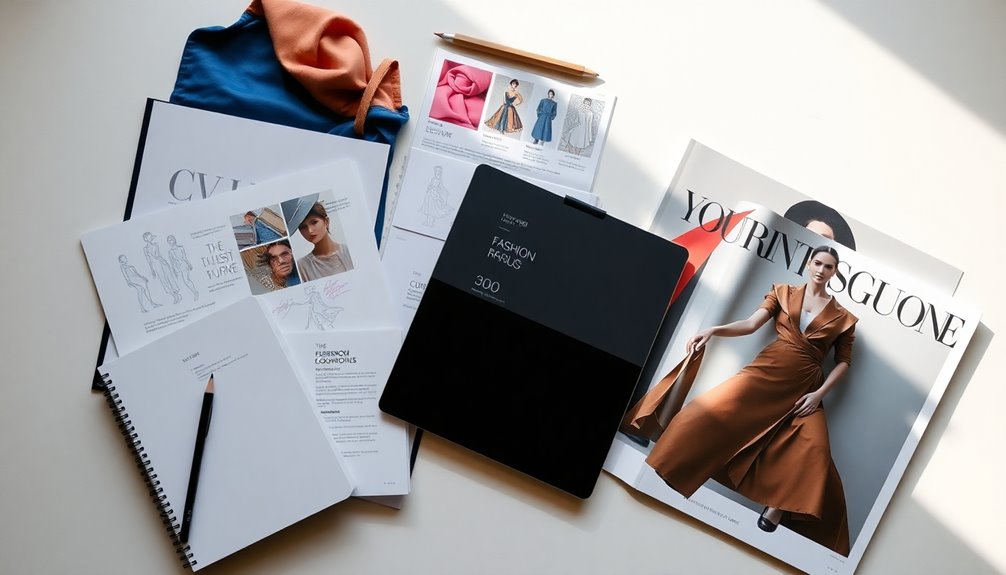
Showcasing projects and portfolios effectively in a fashion CV can make a striking impact on potential employers. Start by selecting relevant projects that resonate with your fashion career goals. Choose a diverse range of works to demonstrate your versatility, ensuring you include recent projects that reflect your current style. If you have any award-winning collections, don't hesitate to feature them.
Detail the design process by including sketches, illustrations, and technical drawings. Share the inspiration behind each project, detailing your research and showcasing fabric swatches, color palettes, and how your designs can be styled with other garments. High-quality visuals are key; use optimized images or videos that capture your work compellingly. Transparency in the design journey builds trust and showcases your growth.
For higher-end brands, include sketched silhouettes, while fast-fashion projects can showcase designs created using Illustrator or InDesign alongside your drawings. A before-and-after approach can highlight the evolution of your work.
Finally, provide context by explaining your design philosophy and the inspirations behind your collections. Mention the target audience to illustrate your understanding of the market. This comprehensive approach will help your projects stand out and showcase your creativity effectively.
Proofreading and Final Touches
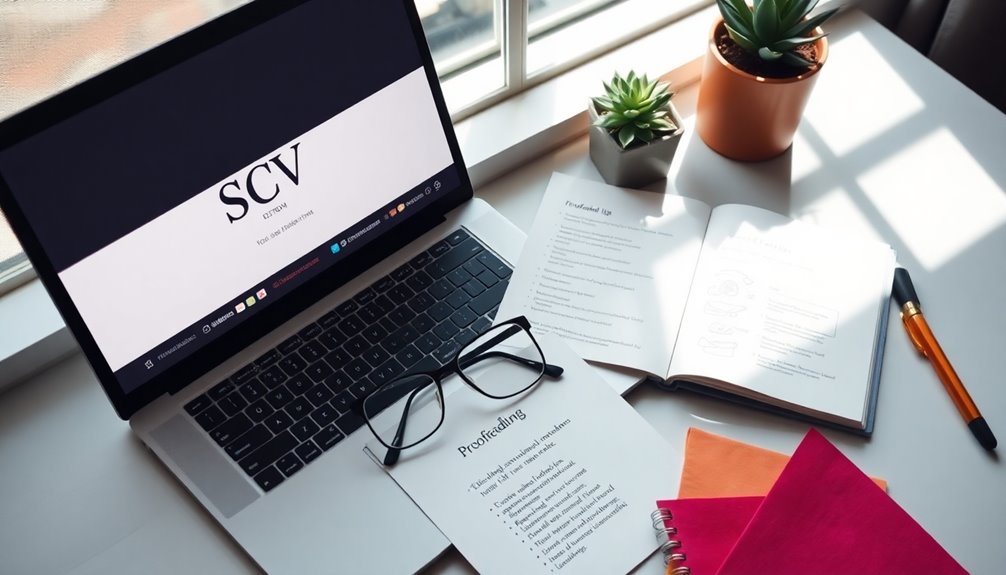
After presenting your projects and portfolios, ensuring your fashion CV is polished and error-free becomes vital. Start by scheduling dedicated proofreading sessions, allowing yourself enough time and focus.
It's best to edit when you're refreshed, so tackle it after a good night's sleep. To effectively catch errors, backtrack through your CV by reading from the end to the beginning, helping you spot spelling mistakes more easily.
Consider printing your CV in a different font, like Times New Roman, to gain a fresh perspective. Use a copy of the file to keep the original format intact.
While proofreading, check for spelling errors, grammar, and punctuation. Don't overlook smaller words and ensure your contact information is accurate and professional. Additionally, be sure to highlight your unique qualifications that set you apart from other candidates.
Conduct multiple rounds of proofreading and seek external feedback from peers or mentors. Update your CV based on their insights and ensure it aligns with relevant keywords from the job description.
Lastly, make use of proofreading tools and online resources to refine your document further. This thorough process will help you create a standout fashion CV that's sure to impress potential employers.
Frequently Asked Questions
How Do I Choose the Right Resume Length for My Experience?
When choosing the right resume length, consider your experience level.
If you've got less than 10 years, stick to one page, focusing on recent and relevant roles.
For more than 10 years, a two-page format allows you to showcase extensive accomplishments.
Always prioritize clarity and relevance, using bullet points to enhance readability.
Tailor your content to the job you're applying for, ensuring it aligns with the employer's expectations.
What Should I Include in My Portfolio as a Fashion Designer?
When you're creating your portfolio as a fashion designer, include high-quality images of your collections along with detailed descriptions.
Showcase sketches, illustrations, and technical drawings to highlight your design process. Document your journey with mood boards, trend research, and testimonials from clients.
Don't forget to feature a capsule collection that represents your unique style and technique, ensuring it tells a cohesive story about your aesthetic and target audience.
How Can I Effectively Network as a Fashion Professional?
To effectively network as a fashion professional, start by attending industry events like fashion shows and workshops.
Research participants beforehand and engage actively in discussions. Don't hesitate to introduce yourself and express interest in others' work.
Build genuine relationships by listening more than you speak, and follow up with personalized messages.
Utilize digital platforms to showcase your skills and connect with industry peers, staying updated on trends to foster meaningful connections.
What Are Common Mistakes to Avoid in a Fashion CV?
When crafting your fashion CV, avoid listing irrelevant jobs that distract from your qualifications. Focus on transferable skills and relevant coursework instead.
Don't over-customize; create a solid baseline and tweak it strategically for each application. Ensure your CV is well-structured and free of errors, using a professional email address.
Tailor your content to the job description and highlight specific skills. A polished presentation can make a significant difference in catching a recruiter's eye.
How Do I Handle Gaps in My Work Experience on My CV?
When handling gaps in your work experience on your CV, be honest and straightforward. List the gap clearly and briefly explain it in your introduction.
Focus on any skills or experiences gained during that time, like volunteering or further education. Present the gap as a valuable period for personal and professional growth.
Finally, tailor your CV to the job by using relevant keywords and emphasizing skills acquired during your time away from formal employment.
Conclusion
In summary, creating a standout fashion CV takes careful planning and attention to detail. By choosing the right format, crafting a compelling summary, and showcasing your skills and projects, you'll present yourself as a strong candidate in the competitive fashion industry. Don't forget to tailor your CV for each opportunity and proofread thoroughly. With these steps, you're well on your way to making a lasting impression and landing that dream role in fashion. Good luck!
